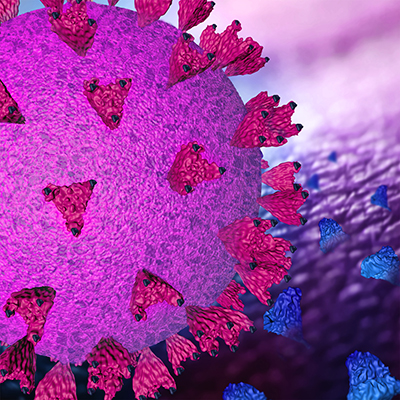March 15, 2023 -- An alternative method for finding single-chain antibodies has yielded COVID-19 drug candidates that may be effective against variants of concern.
Throughout the pandemic, some research groups have evaluated the potential to use small, single-chain antibodies, which are known as nanobodies, to target the SARS-CoV-2 coronavirus. Nanobodies have potential advantages over monoclonal antibodies, a modality that has been authorized for use against COVID-19, because they can bind to regions of the virus that are inaccessible to the larger molecules.
Mutations in the virus can render nanobodies ineffective, as has happened to monoclonal antibodies, but the smaller molecules can work synergistically to target the entire SARS-CoV-2 spike protein and thereby remain effective against variants of concern.
Researchers at Rockefeller University first demonstrated the potential of nanobodies using a mass spectrometry (MS)-based approach. The scientists immunized llamas with spike constructs and used MS to identify molecules with high affinity for the protein. While the method identifies promising prospects, it requires infrastructure and expertise and is expensive and time-consuming to perform.
Writing in the Journal of Biological Chemistry, the Rockefeller researchers describe a different way of discovering nanobodies against SARS-CoV-2. The paper describes a yeast display method, an approach used by another group earlier in the pandemic to find an anti-SARS-CoV-2 nanobody. Building on the earlier paper, the Rockefeller team tried to simplify and optimize the yeast display method.
The resulting screening process identified many of the nanobodies selected by the MS-based approach, plus a large new set of nanobodies with high affinities and neutralization activities against SARS-CoV-2 variants. Compared to the MS-based approach, the yeast display method achieved comparable efficiency and specificity without requiring the same level of infrastructure and expertise.
The potential for the yeast display method to lower the barriers to discovering nanobodies against the coronavirus and other targets is central to its appeal, as Michael Rout, PhD, a Rockefeller professor, explained in a statement.
"Our method is more straightforward and less expensive than existing techniques. You do need a llama, but that -- along with all the most complicated parts of the process -- can be outsourced," Rout said. "A researcher anywhere in the world, with fairly limited resources, could use this technique. The llama-related stuff could be FedEx-ed from North America."
Rout and his collaborators remotely accessed commercial llama and sequencing resources for their project, supporting the assertion that those activities can be outsourced, and contend that any lab with standard resources and skill sets can use the approach to generate nanobodies.
Copyright © 2023 scienceboard.net











